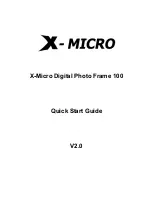
111
110
Notes on Using Your Camera Correctly
■
Places to Avoid
Do not store or use the camera in the following types of
locations:
h
In the rain or in very humid, dirty or dusty places.
h
In direct sunlight or in places subject to extreme
temperature rises, such as in a closed car in summer.
h
Extremely cold places.
h
Places subject to strong vibration.
h
Places affected by smoke or steam.
h
Places subject to strong magnetic fields (such as near
motors, transformers or magnets).
h
In contact with chemicals such as pesticides or next to
rubber or vinyl products for long periods of time.
■
Notes on Immersion in Water or Sand
The FinePix S3000 is particularly adversely affected by
water and sand. When you are at the beach or close to
water, ensure that the camera is not exposed to water or
sand. Take care also not to place the camera on a wet
surface. Water or sand inside the camera can cause faults
that may be irreparable.
■
Notes on Condensation
If the camera is carried suddenly from a cold location into a
warm place, water droplets (condensation) may form on
the inside of the camera or on the lens. When this occurs,
switch the camera off and wait an hour before using the
camera. Condensation may also form on the
xD-Picture
Card
. In this event, remove the
xD-Picture Card
and wait
a short time before using it again.
■
When the Camera is Unused for Long Periods
If you do not intend to use the camera for a long period of
time, remove the batteries and the
xD-Picture Card
before
storing the camera.
■
Cleaning Your Camera
h
Use a blower brush to remove dust from the lens, LCD
monitor screen or viewfinder as these surfaces, and then
wipe lightly with a soft, dry cloth. If any soiling remains,
apply a small amount of lens cleaning liquid to a piece of
FUJIFILM lens cleaning paper and wipe gently.
h
Do not scratch hard objects against the lens, LCD
monitor screen or viewfinder as these surfaces are easily
damaged.
h
Clean the body of the camera with a soft, dry cloth. Do
not use volatile substances such as thinners, benzine or
insecticide, as these may react with camera body and
cause deformation or remove the coating.
■
Using the Camera Overseas
When travelling overseas, do not place your camera in the
check-in baggage. Baggage handling at airports may
subject baggage to violent shocks, and the camera may be
damaged internally even when no external damage is
visible.
e
Be sure to read this information in conjunction with “Safety Notes” (
➡
P.126), to ensure that you use
your camera correctly.
●
SC-FX304
This is a special case made of polyester that protects the camera against soiling,
dust and minor impacts when it is being carried.
h
PC Card Adapter DPC-AD
The PC Card Adapter allows the
xD-Picture Card
and SmartMedia to be used as
a PC Card Standard ATA-compliant (PCMCIA 2.1) PC card (Type
II
).
h
Compatible with
xD-Picture Card
of 16 MB to 512 MB, and SmartMedia of
3.3V, 2 MB to 128 MB.
h
CompactFlash™ Card Adapter DPC-CF
Loading an
xD-Picture Card
into this adapter allows you to use the card as a
CompactFlash card (Type
I
).
h
Windows 95/98/98 SE/Me/2000 Professional/XP
h
Mac OS 8.6 to 9.2/X (10.1.2 to 10.1.5)
COM
PACT
FLAS
H
DPC
-CF
TM
for
xD-P
icture
Card
CAR
D AD
APTE
R
h
Image Memory Card Reader DPC-R1
The DPC-R1 provides a quick and easy way to transfer images back and forth
between your PC and an image memory card (
xD-Picture Card
and
SmartMedia). The DPC-R1 uses the USB interface for high-speed file transfer.
h
Compatible with Windows 98/98 SE, Windows Me, Windows 2000 Professional,
Windows XP or iMac, Mac OS 8.6 to 9.2.2, Mac OS X (10.1.2 to 10.2.2) and
models that support USB as standard.
h
Compatible with
xD-Picture Card
of 16 MB to 512 MB, and SmartMedia of
3.3V, 4 MB to 128 MB.
Accessories Guide











































